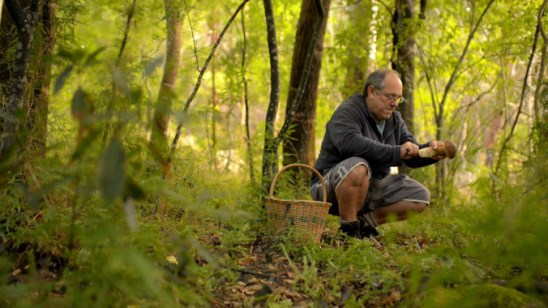Once you’ve read Sylvia Plath’s spooky poem Mushrooms, you never look at these fungi in quite the same way again: Overnight, very/ Whitely, discreetly,/ Very quietly/ … Nobody sees us,/ Stops us, betrays us;/ … Earless and eyeless,/ Perfectly voiceless,/ … So many of us!/ So many of us!/ … Nudgers and shovers/ In spite of ourselves./ Our kind multiplies:/ We shall by morning/ Inherit the earth./ Our foot’s in the door.
More like creatures than plants, they are mysterious, alluring and dangerous, seemingly appearing out of nowhere, “mushrooming” overnight on the forest floor. Their apparently soft little bodies can push through tarmac, and yet they can all but dissolve in your mouth in a good beef stew or chasseur sauce.
But as foraging has become more popular and chefs more adventurous, wild mushrooms — those that cannot be propagated commercially — have started appearing in the city’s local markets and on restaurant menus. Wild mushrooms on toast or in omelettes are now popular breakfast items, as are kebabs for lunch made of multiple species of mushrooms.
Not many people realise that the button mushrooms, brown mushrooms and Portobello mushrooms we find on our supermarket shelves are actually all the same mushroom just harvested at different times of its development.
Mycological autodidact Gary Goldman hopes to start a South African revolution, waking locals up to the extraordinary variety of edible mushrooms on their doorstep, mostly free for the taking. He has eaten some 23 local species.
Goldman says residents of the Western Cape are especially lucky as there are no flies that are specifically drawn to mushrooms, unlike in the Americas, where by 11am the forest mushrooms nearly all have maggots laid in them.
Mushroom hunters can be a secretive bunch, because once you have found a spot, you can be absolutely sure that (unless it is vandalised) mushrooms will appear in exactly the same place every year.
But wild mushrooms are tricky and notorious things. Some cannot be eaten raw, some local mushrooms (like the shaggy ink cap) turn toxic if drunk with wine, and some are deadly. One species, the death cap or Amanita phalloides, is the most poisonous mushroom known and I have come across it in the Cape forests. Once symptoms appear six to 24 hours after ingestion, the damage to the kidneys, liver and pancreas is irreversible and fatal. Never eat a mushroom you are not 100% sure about.
Fortunately for those who want to learn, the good folk at Delheim wine estate in Stellenbosch organise an annual mushroom week in June, with an illustrated lecture and a forage in the forest on the Simonsberg, followed by a three-course mushroom menu in the Delheim restaurant.
From June to August is mushroom high season in the Western Cape. Among the most delectable fungi found are the alien pine ring, which the French call “vegetable livers”; the sulphur shelf, also known as “chicken of the woods” as it tastes like chicken breast and appears as early as February and March; the blusher, which also appears in summer and autumn and is edible only when cooked; the wood blewit, which only appears when it is very cold at the end of July (little known to South Africans, French residents, Goldman says, know it, find and gobble them up quickly); the field mushroom (which unfortunately needs expertise to tell it apart from the deadly poisonous Amanita verna); and the champion of culinary fare — the porcini.
Goldman found one weighing 1.6kg and has picked as much as 50kg of porcini in just one morning. After our forage through Delheim’s enchanted woods, we return with baskets of mushrooms, including a porcini half the size of my forearm. The restaurant has prepared a special menu for us hungry foragers — papino and shimeji salad, wild mushroom tartlet, Boletus edulus risotto, exotic mushroom tagliatelle, and — to finish — mushroom and apricot biscotti.
Delheim’s Nora Sperling-Thiel says it is a family passion. “Today foraging classes, guidebooks, internet buzz and even mushroom-identification smartphone apps have brought mushroom hunting into mainstream foodie culture, but for us this all started four years ago already.”
Delheim was the originator of the now popular concept of fungi foraging events in the country and has since definitely managed to raise awareness for mushroom foraging in South Africa.
There is plenty out there to discover. But one must be sure of one’s facts. Goldman repeats the old story: “There are bold and there are old mushroom hunters, but there are no old, bold mushroom hunters.”
Gary Goldman happily helps foragers to identify mushrooms. For more info visit www.mushroomguru.co.za Delheim restaurant, Knorhoek Road off the R44, Stellenbosch, is open Mondays to Sundays for breakfast and lunch. Tel: 021 888 4600
This article first appeared in the Mail & Guardian on 8 August 2014.

